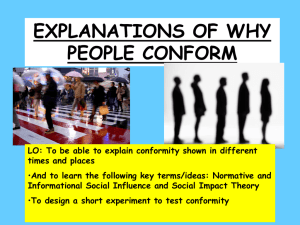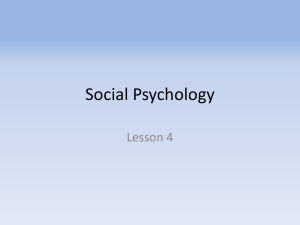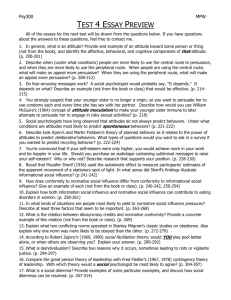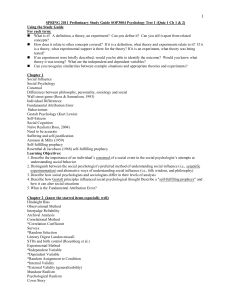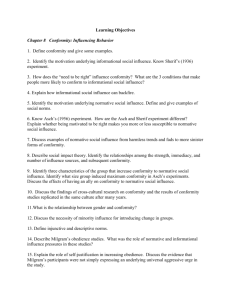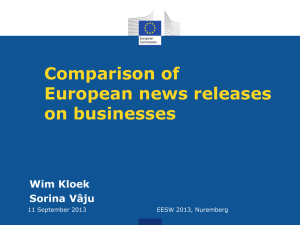Social Influence - Beauchamp Psychology
advertisement
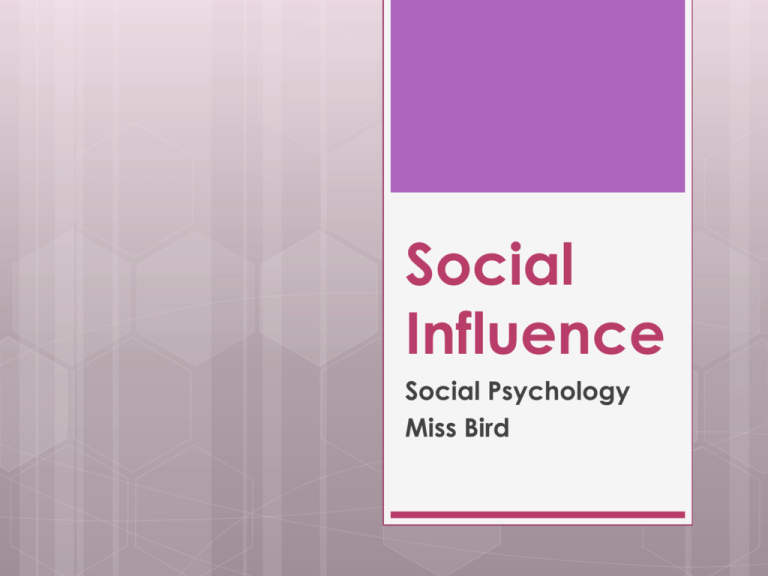
Social Influence Social Psychology Miss Bird Homework due 1) Research and make notes on the key study on minority influence by Moscovici et al (1969) - APFCC. 2) Complete the 4-mark past-exam question on conformity (blue worksheet) – COLLECTING IN TO MARK. OVERVIEW: Conformity Sometimes we conform to ‘fit-in’ with those around us – COMPLIANCE. Sometimes we are not sure of the right way to think or act so we use others as a source of information and accept their viewpoint– INTERNALISATION. Exam information In the exam you may be asked: 1) ‘Types of conformity’ – compliance and internalisation. 2) Explanations of why people obey – normative social influence and informational social influence. Explanations of why people conform 1. Normative social influence – ‘follow the crowd.’ 2. Informational social influence – accept majority viewpoint as most likely to be right. Normative Social Influence (NSI) It is possible to behave like the majority without accepting its point of view. COMPLIANCE = Public agreement but no private attitude change. A majority may be able to control other group members by making it difficult for them to deviate from the majority point of view, thus exerting pressure on them to conform. ‘Fit-in,’ ‘acceptance,’ ‘approval.’ Evaluation of NSI Bullying Research has shown how many groups with a low quality of interpersonal friendships may be manipulated by a skilful bully so that victimisation of another child provides the group with a common goal. This exerts pressure on all group members to comply (for fear of being rejected themselves). Evaluation of NSI Smoking Marketing campaigns aimed at educating young people about what is normative in a particular group have been successful in reducing the incidence of risk behaviours (alcohol abuse and smoking). Social norms bring about conformity. Strong link between people’s normative beliefs and their behaviour. Campaign aimed at 12-17 year olds – only 10% of non-smokers subsequently took up smoking following exposure to a message that most children in their age group did not smoke. Evaluation of NSI Conservation behaviour Aim: persuade hotel guests to reuse their towels rather than having fresh ones every day. 132 hotels – 794 rooms – guests in 1 week. Rooms randomly assigned to either experimental or control condition. Control – door hanger informing guests of environmental benefits of reusing their towels. Experimental – door hanger + informed that ‘75% of our guests choose to reuse their towels each day.’ Guests who received additional message that contained normative information about other guests reduced their need for fresh towels by 25%! Informational Social Influence (ISI) Individuals go along with others because they believe them to be right. Use them as a source of information. Don’t just comply in behaviour but also change own point of view. INTERNALISATION = changes to both public and private attitudes. Informational Social Influence (ISI) ISI more likely if: 1. 2. 3. Situation ambiguous (right course of action unclear). Situation is crisis (rapid action needed). We believe others to be experts (more likely to know what to do). Independent task Complete the gap fill exercise in your booklet on the evaluation of ISI. You have 5 minutes in silence. Be prepared to feedback to the class. Independent task Consolidation On A3 paper, draw a mindmap of the two explanations for why people conform (NSI and ISI). You have 20 minutes. Exam focus January 2011 Complete the past-exam question in your booklets. It is worth 6 marks. No notes! You have 6 minutes in silence. Try and write a model answer.
